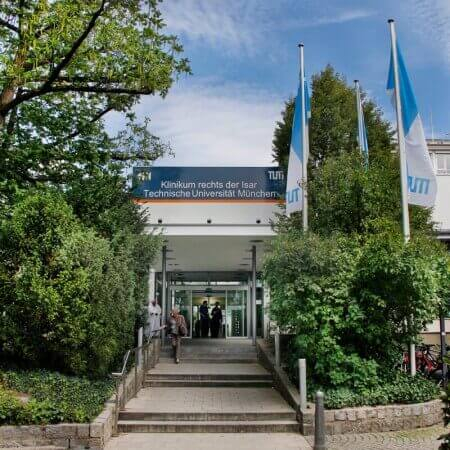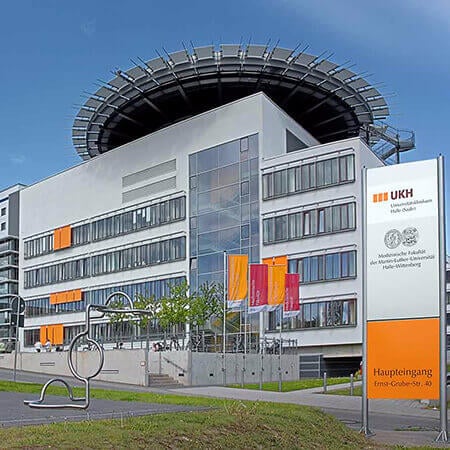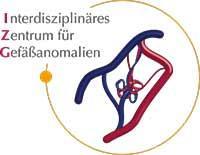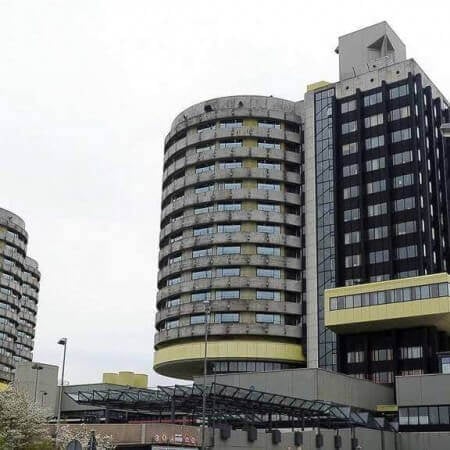Lung Cancer — Embolization or Chemoembolization: treatment in the Best Hospitals in the World
Treatment prices are regulated by national law of the corresponding countries, but can also include additional hospital coefficients. In order to receive the individual cost calculation, please send us the request and medical records.

Department of Interventional Radiology
The Department of Interventional Radiology offers the full range of imaging examinations, as well as innovative image-guided minimally invasive techniques for the treatment of tumors, vascular diseases and internal pathologies (for example, CT, MRI, PET-CT, SPECT). The department's doctors have deep knowledge and colossal experience in the field of interventional radiological methods of treatment, which represent an excellent alternative to open surgical interventions. Despite the high level of technical equipment and the presence of advanced computerized systems, the focus is always on the person with his individual needs. Compliance with current clinical protocols and high professionalism of the department's specialists contribute to the successful clinical practice, as well as the reputability of the department among the best medical facilities of this kind in Germany.




Department of Interventional Radiology and Neuroradiology
The Department of Interventional Radiology and Neuroradiology offers a full range of advanced imaging diagnostics and minimally invasive treatments on both an inpatient and outpatient basis. The department has state-of-the-art medical equipment for imaging tests such as X-ray, computed tomography, magnetic resonance imaging, digital subtraction angiography, and mammography. The medical facility also performs many highly effective interventional therapeutic procedures under image guidance, which in many cases allow patients to avoid traumatic open surgery. For example, the department successfully performs local fibrinolysis, thrombectomy, percutaneous transluminal angioplasty, hemostasis, transarterial chemoembolization, uterine artery embolization, and other procedures. The department's neuroradiologists specialize in brain and spinal cord imaging and the treatment of central nervous system disorders. Interventional neuroradiology focuses on the treatment of carotid artery stenosis, brain aneurysms, arteriovenous malformations, dural fistulas, subdural hematomas, brain tumors, skull base and spinal tumors, and chronic back pain. The department's medical team has extensive clinical experience in their areas of expertise. The specialists are guided by the recommendations of the German Society for Interventional Radiology and Minimally Invasive Therapy (DeGIR) and the German Society for Neuroradiology (DGNR), which helps to achieve the best results.






Department of Adult and Pediatric Diagnostic, Interventional Radiology, Neuroradiology
The Department of Adult and Pediatric Diagnostic, Interventional Radiology, Neuroradiology is one of the best institutions of its kind in Germany and offers patients the full range of radiological studies and imaging-guided minimally invasive therapy. The department’s scope of tasks also includes imaging diagnostics in children of all age groups, detection and invasive treatment of cerebral vascular pathology (neuroradiology). Patient care is provided both on an inpatient and outpatient basis.






Lung cancer is the most common disease in oncology. Moreover, it is one of the most dangerous, prognostically unfavorable cancers. The most effective treatment method is surgery, but neoplasms are usually detected at the advanced stages, so only 20% of patients are operated on. Other people receive chemoradiation therapy. Bronchial artery embolization is increasingly used in Europe for the treatment of inoperable lung cancer. As a result of the procedure, the tumor sometimes decreases in size and the doctor can remove it surgically in an attempt to cure the disease.
Content
- In what cases can embolization be used
- Mechanisms of action of chemoembolization
- Embolization in combination therapy for lung cancer
- How is the procedure performed
- Embolization in palliative cancer treatment
- Embolization results
- Why is it worth undergoing embolization abroad
- Treatment in Europe with Booking Health at an affordable price
In what cases can embolization be used
Late diagnosis or low lung functional reserves are the main reasons for refusing surgery. Although surgery is the most effective treatment method and in fact the only one, which gives a chance to cure the disease, radical surgical interventions are not performed in most patients.
In such cases, chemoradiotherapy becomes the main method of lung cancer control. However, it has many disadvantages: high toxicity, frequent complications.
Doctors increasingly use additional methods of local tumor control, namely ablation and embolization. Embolization is considered one of the best methods in terms of the ratio of effectiveness and safety. This is a minimally invasive procedure, which reduces the tumor size and stops pulmonary hemorrhage.
This technique for lung cancer treatment has the following advantages:
- Suppression of the tumor due to three mechanisms: the closure of blood vessels, the destruction of cancer cells by cytostatics and an increase in the immune response.
- Minimally invasive procedure, which is performed through the blood vessels.
- Low risk of complications.
- Good treatment tolerance.
- Technique can be combined with any other treatment methods for lung cancer.
Mechanisms of action of chemoembolization
If the only purpose of the procedure is to stop pulmonary hemorrhage, then it involves only closing the lumen of the bronchial, less often other arteries. However, other goals are more often pursued. These may be reducing the size of the tumor, achieving a state of resectability (the possibility of surgical removal), and stabilizing the size of the neoplasm. Therefore, artery embolization for lung cancer patients is usually combined with regional chemotherapy.
The mechanisms of action of chemoembolization are as follows:
- Ischemic tissue necrosis. The tumor receives much blood and quickly grows. If the blood flow is stopped, the cells quickly die due to the lack of oxygen.
- The impact of chemotherapy agents. They are injected into the tumor through the arterial network at a high concentration. With the use of drug-eluting microspheres, the drugs are released gradually over several weeks. Regional chemotherapy is more effective than systemic chemotherapy. This is due to the fact that a large concentration of cytostatics is created in the tumor. It would be impossible to create it with intravenous administration of drugs due to the unacceptable toxicity of high dosages of drugs.
- Closure of bleeding arteries. Hemoptysis is the main problem of patients. It limits the possibilities of treatment, since ongoing bleeding and a weakened condition of patients are contraindications not only for surgery, but also for radiation therapy. While stopping bleeding, embolization prevents the fatal complications of lung cancer and makes it possible to use other treatment methods.
- Stimulation of antitumor immunity. It is achieved by stimulating the inflammatory process. A few days after embolization, the patient develops bacterial bronchitis. Immune cells, namely macrophages and T lymphocytes migrate to the inflammation area. They produce factor-alpha (cachectin) tumor necrosis. This substance destroys cancer cells. In addition, cachectin blocks angiogenesis – the formation of new vessels that supply the tumor.
Embolization in combination therapy for lung cancer
Bronchial arterial chemoembolization is used in cases when the patient is considered inoperable. However, as a result of a successfully performed procedure, some patients can achieve a resectable state.
Surgery is the preferred treatment option. If it is impossible to carry out radical intervention, this actually means the impossibility of curing the disease. Therefore, the efforts of doctors are aimed at reducing the size of the tumor, its metastases, and achieving a resectable state of the tumor. One of the options for achieving this goal is chemoembolization.
The procedure is performed using microspheres saturated with chemotherapy drugs. It is also possible to use oily chemoembolization – the vessels are blocked with a solution of lipiodol with chemotherapy drugs. When the embolization agents are injected into the bronchial artery, the tumor stabilizes (stops growing) in about half of the patients. In one in three cancer patients, the tumor is reduced enough that doctors may suggest radical surgery to try to cure cancer.
Resectability is even more often achieved if patients receive radiation therapy after embolization. Doctors use high doses of radiation to reduce the tumor. As a result, radical surgery can be performed in half of the patients.
With unresectable cancer, embolization can be combined with ablation. This is a treatment method, which involves the destruction of the tumor by heating it. Radiofrequency ablation is used more often, microwave ablation is less often carried out.
With the combination of these two techniques, the first is endovascular embolization. The lumen of the vessels is closed, so a significant part of the tumor dies off. Reduction of the tumor blood supply is an important condition for the success of radiofrequency ablation. The procedure is performed a few days after bronchial artery embolization. The doctor inserts a probe into the tumor and heats it up to destroy the remaining cancer cells. The combined technique allows the doctors to reduce the tumor by 2-3 times. It increases life expectancy, eliminates pulmonary hemorrhage and restores bronchial patency.
How is the procedure performed
Artery embolization for lung cancer is performed through a small incision in the groin. The doctor inserts a catheter into the femoral artery and reaches the bronchial artery. The doctor carries out angiography: clarifies the characteristics of the blood flow in the tumor. He injects a contrast agent into the vessels and then takes a series of X-rays to assess the movement and distribution of the contrast agent.
Most lung tumors are supplied from the bronchial artery. They branch out at the edge of the neoplasm and become wavy, penetrate into the thickness of the tumor node and form a rich vascular network.
However, in different people, the vessels of the lung are arranged in different ways. Some have only one bronchial artery for each lung, others have several, ranging from 2 to 4. They can extend from the thoracic aorta, while in other patients from the intercostal artery. In 30% of cases, the bronchial arteries have an aberrant discharge: their sources are the subclavian arteries, intercostal arteries, brachiocephalic arteries, lower phrenic arteries and even branches from the abdominal aorta. The vessels can supply blood not only to the bronchial wall, but also to the adjacent fiber, lymph nodes, and nerves.
The blood supply to the tumor is also different. Sometimes it receives almost all of the blood from the basin of one large artery. Other patients have multiple sources of blood supply. In this case, the embolization procedure is less successful, and therefore doctors often refuse to carry it out. In addition, the procedure becomes dangerous if anastomoses (connections) of the bronchial artery with the vertebral, spinal, intercostal or cervical arteries are detected.
If chemoembolization is possible, then the embolization agent is injected into the vessels supplying the tumor. Their lumen closes and the cancer cells die. An area of fibrosis (scar tissue) is formed in the place where the tumor is located.
Embolization in palliative cancer treatment
Cancer patients receive palliative care at the advanced stage. It can increase life expectancy, but it is aimed primarily at improving its quality.
The main problems of patients at the advanced stage of the disease are shortness of breath due to obstruction (closure of the lumen) of the bronchi, hemoptysis and pulmonary hemorrhage, accumulation of effusion in the pleural cavity. Embolization is one of the palliative treatment options, which in combination with other procedures and surgeries, can help eliminate most of the symptoms and complications.
First of all, embolization is used to combat pulmonary hemorrhages. They cause anemia, make it impossible to carry out chemoradiation therapy, and in some cases become the direct cause of the patient's death. Doctors perform an endovascular procedure to close the lumen of all bronchial arteries supplying the tumor. In this case, the hemorrhage is stopped almost instantly. The procedure is successful in 96% of cases. In case of failure, the manipulation can be repeated.
Massive pulmonary hemorrhage is very dangerous without treatment – it has a mortality rate of up to 50%. Hemorrhage with a loss of more than 200 ml of blood per hour requires embolization, first of all. If the patient has respiratory failure, then even coughing up 50 ml of blood per hour is considered dangerous. In 90% of cases, the source of this hemorrhage is the bronchial arteries, which are usually closed during embolization.
This procedure is usually combined with various methods of restoring the patency of the bronchial tree. Doctors use laser, radiofrequency ablation, photodynamic therapy, and other techniques. After the destruction of the part of the tumor, which blocks the bronchus, it is possible to implant a stent, which prevents recurrent neoplastic obstruction.
Embolization results
Thus, embolization and chemoembolization are effective treatment methods for unresectable lung cancer. Depending on the stage of the pathology, the goals of the procedure and its results vary significantly in different patients. As a rule, the results are as follows:
- Achievement of tumor resectability. Previously, cancer could not be removed, so the patient had no chance of defeating the disease. However, there is a possibility of a significant reduction of the tumor size as a result of chemoembolization. If successful, the procedure is followed by radical surgery to remove the malignant lung tumor. The prognosis is better in patients with blood supply to the neoplasm via one bronchial artery.
- Increased life expectancy. Even if surgery is not possible, the tumor can be controlled for several more years. As a rule, doctors use a combination of several techniques. Embolization is most commonly combined with chemotherapy, radiation therapy, and cancer ablation.
- Arrest of hemorrhage. Pulmonary hemorrhage is possible even in patients with small lung tumors. In this case, they make it impossible to carry out surgery or irradiation. In advanced stages of cancer, lung hemorrhage is one of the main causes of death for patients who usually die not from blood loss, but as a result of asphyxiation (suffocation), since blood blocks breathing. Embolization allows the doctors to stop even the most severe hemorrhage and eliminate hemoptysis for at least several months.
Why is it worth undergoing embolization abroad
Cancer hospitals abroad have state-of-the-art equipment. They employ specialists with vast experience in performing bronchial artery embolization. You can be confident that the treatment in Europe will ensure the best results with the lowest risk of complications.
There are several reasons for you to undergo embolization for lung cancer in Europe:
- Vast experience in carrying out embolization and chemoembolization in lung cancer.
- The use of new methods of chemoembolization, including the use of drug-eluting microspheres.
- Highly accurate diagnostics of lung cancer, allowing for perfect planning of the procedure.
- During embolization, doctors perform angiography and accurately assess the blood flow in the tumor to avoid complications caused by penetration of embolization agents into non-target vessels.
- Doctors combine chemoembolization with other lung cancer treatment methods to make the tumor resectable and maximize the patient's life expectancy.
Treatment in Europe with Booking Health at an affordable price
To undergo treatment in one of the European hospitals, please use the services of the Booking Healthcompany. On our website, you can see the cost of treatment in different European hospitals, compare prices and book a medical care program at an affordable price. Embolization of arteries in European hospitals will be easier and faster for you, and the cost of treatment will be lower.
Please leave your request on our website. Our employee will contact you and provide consultation about the treatment in Europe. Booking Health will take care of the organization of your trip. We will provide the following benefits for you:
- We will select a hospital for treatment in Europe, whose doctors specialize in the treatment of lung cancer patients and achieve best results.
- We will help you overcome the language barrier, establish communication with your attending physician.
- We will reduce the waiting period for the medical care program and book a doctor's appointment on the most suitable dates.
- We will reduce the price. The cost of treatment in European hospitals will be decreased due to the lack of coefficients for foreign patients.
- We will take care of all organizational issues: documents for entering the country, transfer from the airport, hotel, interpreting services, etc.
- We will prepare a medical care program and translate medical records. You do not have to undergo previously performed diagnostic procedures.
- We will provide communication with the hospital after treatment in Europe.
- We will organize additional examinations and treatment in European hospitals, if necessary.
- We will buy medicines abroad and forward them to your native country.
- We will help you keep in touch with the hospital and the doctor after treatment in Europe.
You will be treated by the best doctors in the world. The Booking Health specialists will help you reduce the cost of treatment and take care of all organizational issues, and you will only have to focus on restoring your health.
Authors:
The article was edited by medical experts, board certified doctors Dr. Vadim Zhiliuk and Dr. Sergey Pashchenko. For the treatment of the conditions referred to in the article, you must consult a doctor; the information in the article is not intended for self-medication!
Sources:

